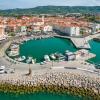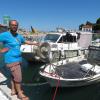Slovenia: Small coast, large fishing tradition.

« I think my grandparents would be happy and proud, » says Tina Steffè Božnik. Proud of this granddaughter, the owner of the Fischhalle Levante in Izola. In a street café right opposite her shop, she sips at the espresso and waves a few friends who
Between IZola’s small old town and are on the move. Tina has a small tattoo on the wrist: a fish. Her grandmother already sold her husband’s catch. This grandfather had his own boat, but also worked on sardine catchers. In 1976 he drove on the one who pulled most of the sardines from all the ships of Yugoslavia that year.
The profession of fisherman has become increasingly difficult in Slovenia
« My father helped his parents, but he worked as a police officer. He interrupted the family tradition, I continued. » If not as a fisherman; This profession has become increasingly difficult. Her father took over his brother’s boat after his death; From then on he employed six people, but had to give up after a few years. « The costs were higher than the income, » said Tina. In 2012 she opened the business when she was 24.
She obtains her goods from fishermen from Izola – a dozen runs regularly here, another from time to time – from the nearby Koper, but also from Croatia and Italy. The grandparents watch her from her portraits in the fish hall.
Photo: Stefanie Bisping
The winding streets of the old town once located on an island, the port full of sparkling yachts and rocking fishing boats, the promenade lined with restaurants, on which it buzzes in the evening by chatting the flaneurs, Izola appears like an early Saint-Tropez: extremely picturesque and still authentic. It has not been long ago that everything was about the fish without glamor. Only the handling of him changed: if the catch was once made with the salt obtained on the same coast, he later landed in the factory at the harbor in doses. Women from fishing families worked here, among them many young girls who saved money for their taxes and soon left the factory.
Some fishermen drive to sea three times in Slovenia
Tina Steffè Božnik, mother of two children, sees her business more as a life’s work. In Croatia, the fish is still being sold much cheaper than in Slovenia, she says, although the prices are now being set up there. Also is Overfishing also in the Adriatic A problem. Also in the nearby Trieste there are only three large fishing boats left in the harbor. Fishing is a seasonal business that is not always sustainable. « When there is white fish in October, some drive out three times a day. » She shakes her head. « Then the prices drop, and at the same time you have high costs because so much fish can be processed. » It has become difficult to make a living for the whole year as Fischer. Many also work in tourism, offer tours for holidaymakers in summer and only go fishing from October to December and between March and May.
Photo: Mazur Travel – Stock.adobe.com
Before that, too, Ivković is the passion for fishing in the genes. “My father drove on big ones for thirty years Sardines– and anchovy catchers, that was a huge business in Yugoslavia, ”says the forty -year -old. He drove out as a teenager for the first time and learned fishing in his free time. Ten years ago he bought his own fishing boat.
« It is a small boat, I only fish near the coast. But if you hang in, you get a lot back. If you are passionate, fishing means that life on the water is still freedom. » But he too has a second job as a port worker. Because not only overfishing is a problem, although anchovies, once the main catch, practically no longer. « We are in a corner of the Adriatic, » he explains. “The fish has to go through Italy And Croatia without being caught before we have access. »
Photo: bisping Stefanie
Slovenia only has a small coast
Slovenia only has 46 kilometers of coast. They line four cities – Ankaran, Koper, Izola and Piran. The maritime border drawn after civil war and decay of Yugoslavia in the middle of Piran’s bay did not give the young Republic access to international waters and therefore hardly helped her. « We shouldn’t have allowed this, » says Marko Starman, once deputy environmental minister of Slovenia and today director of the 428 hectare National Park Strunjan, whose salt pans and salts join the town south. Because the Slovenian were limited by Italian and Croatian state waters; Slovenia only had access to the Adriatic on the doorstep. This was followed by years of struggle for a arbitration court in Slovenia in 2017 three quarters of Piran’s bay and a corridor by Croatian waters – which the neighbor did not accept.
Since then, the animosities have continued, but on a small flame. After all, everything has been in the river in the region for a long time. In 1954 it was unclear who belonged where; At that time, more Slovenians lived in Trieste than in Ljubljana. The experience from the past has raised awareness of the value of linguistic diversity and individual freedom. At the same time, they have proven that geographical limits are insufficiently reflecting on the realities of life. Schools and kindergartens are bilingual, the Italian-language minority always provides Izola’s vice mayor.
Seemann kitchen at star level in Zagorje
Politics end where culinary art begins. In 2003, Koch Ivek Evačić born in Croatian Zagorje took over the kitchen in the restaurant of the Hotel Marina at the harbor. With his passion for the kitchen of the Mediterranean and a clear vision of genuine, locally shaped cuisine, he raised the restaurant to a new level and established it as a gourmet address. The Guide Michelin praises his irresistible « regional and traditional sailor’s cuisine ». From his restaurant, the 47 -year -old chef sees the sea, which he owes its most important products – in addition to the cold -pressed olive oil from his own production. He processes them into delights such as pasta with scampi and scallops, polenta with stockfish and scallop cream and fish plates with perfectly prepared side dishes. Boats swings in the water. Beach goers are on the way to the pine grove, where they spread their towels in the shade before they dive into the sea. « I love what I do, » says Evačić. « This is a good place. »
Practical tips for Izola
Sleep: In a beautiful patrician building from the 18th century this is
Boutique Hotel Grassi with ten modernly furnished rooms and partly equipped with jacuzzi. The DZ with a lush breakfast costs here in July from 200 euros.
Feast: Delicious seafood and fish dishes in the daily open
Restaurant Marina of the hotel of the same name.
Fresh fish and mussels also focus in the Sidro restaurant, where you sit nicely with a view of promenade and harbor (do locked, Sončno Nabrežje 24).
Not miss: The Izolana Museum in the old town explains Izola’s story
vividly on several floors. Who Slovenian wine, olives and others
Want to take delicacies home with you is right in the Božič vinotheque.
General information: Slovenian tourist office: www.slovenia.info









